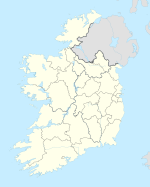User:MFIreland/Aiken Barracks Dundalk
| Aiken Barracks | |
|---|---|
Dún Mhic Aogáin | |
| Dundalk, Ireland | |
| Coordinates | 54°00′20″N 6°22′49″W / 54.005575°N 6.380192°W |
| Type | Military Barracks |
| Garrison information | |
| Garrison | 27 Infantry Battalion |
[edit]
A duel between Colonels:
In 1807 the unit in garrison was the 1st Royal Dragoons, and in an article on " The Barracks and Posts of Ireland," published in An Cosantoir (The Irish Defence Journal) in June 1971, Comdt. P.D. O'Donnell gives a summary of a duel that took place on the 1st June 1807 between Colonel John Slade and his second-in-charge Lieutenant Colonel Charles Cerjat. This duel, "the only one ever to have taken place in The Royals", was fought in the playing field of the Barracks. Both parties fired and missed. Colonel Slade was about to ask for his second pistol when Cerjat's second announced that he had purposely fired to one side. The seconds then decided that honour was served and both could leave, but not without the remark by Slade's second that the Colonel could never be satisfied with Cerjat's conduct. The conduct that led to the duel was that Cerjat met Colonel Slade while both were walking on a Sunday in the main street of Dundalk. Cerjat, who had some differences with his Commanding Officer in 1800 had " quiehe Service the week before. The Gazette had arrived that Sunday morning so it appeared that Cerjat purposely set out to meet his former Commanding Officer. When he did so he verbally attacked Colonel Slade using " most opprobrious language.' He told Slade that the Colonel had " acted like a villain to him." Slade reported in a letter to a friend that " I checked my anger, and made no reply but, very well, I was in regimentals and he was not, or I certainly should have put him to death on the spot." The matter ended with Slade's general writing to him saying he had acted properly and that Cerjat must have been insane " although such recontres (duels) are not permitted but under the most urgent necessity." Slade later became a general and served in Tullamore. The full extent of the Parliament Square complex can he gauged from a ' Return of Barracks ', made in 1811 which deemed it capable of accommodating two hundred cavalry with their horses, and seven hundred infantry. In 1816 the Rev. Elias Thackeray in a attical survey of Dundalk parish, described it thus,
"the barracks is an extensive square, situated upon the sea-shore and is at the distanceof an English mile from the main street. It is capable of containing 700 infantry and 200 cavalry, and has good accommodation for officers. It was originally built by a grant ,from Parliament, from which circumstance it's denomination of Parliament Square has been derived, but the cambric manufacture for which it was designed not proven successful, it was converted to its present use ".
This conversion included the construction of a number of three storey buildings to the north of the square and running from east to west, and one of which still stands just inside the Barrack Street gate. At least two more of these buildings survived into the 20th century with one being demolished in the 1930s, and the second, which had been utilised as the regimental hospital, and which stood on the site of the present officers mess, being demolished in the rebuilding programme of the 1970s.
Dundalk; A Cavalry Barracks:
In 1825, however, an extensive rebuilding programme began, which resulted in the remaining buildings of the original Parliament Square complex being demolished, and reconstructed as a cavalry barracks capable of accommodating a full cavalry regiment with infantry and reserve corps attachments. Buildings constructed at this time Include; the present, four billet blocks on the east and west sides of the square, the home stables to the south of the square, the riding school and forage yard to the south west of the square. An imposing three storey building for officers quarters was also added on the north side of the square. The Cavalry Barracks was completed in 1832, and over the next seventy years Dundalk was garrisoned by alternating units of dragoons, lancers and hussars. 'In 1844 the occupying unit was the 11th Hussar (Prince Albert's own) commanded by Lord Cardigan, who ten years later, at Ballaclava, led this unit along with 17th Lancers, the 4th, 8th and 13th Hussars in the famous 'Charge of the Light Bre'. In fact all of the units which took part in that encounter served in Dundalk Barracks during the 19th century, the last being the 13th Hussars in 1884. Incidentally it was during this period of garrison duty by the 13th Hussars that a relatively unknown officer by the name of Baden Powell served as a major with this unit. Later, of course, during the South African (Boer) war, Baden Powell commanded the British forces during the siege of Mafeking, at which time he was inspired by an idea that later led to his founding the first boy scout movement.

